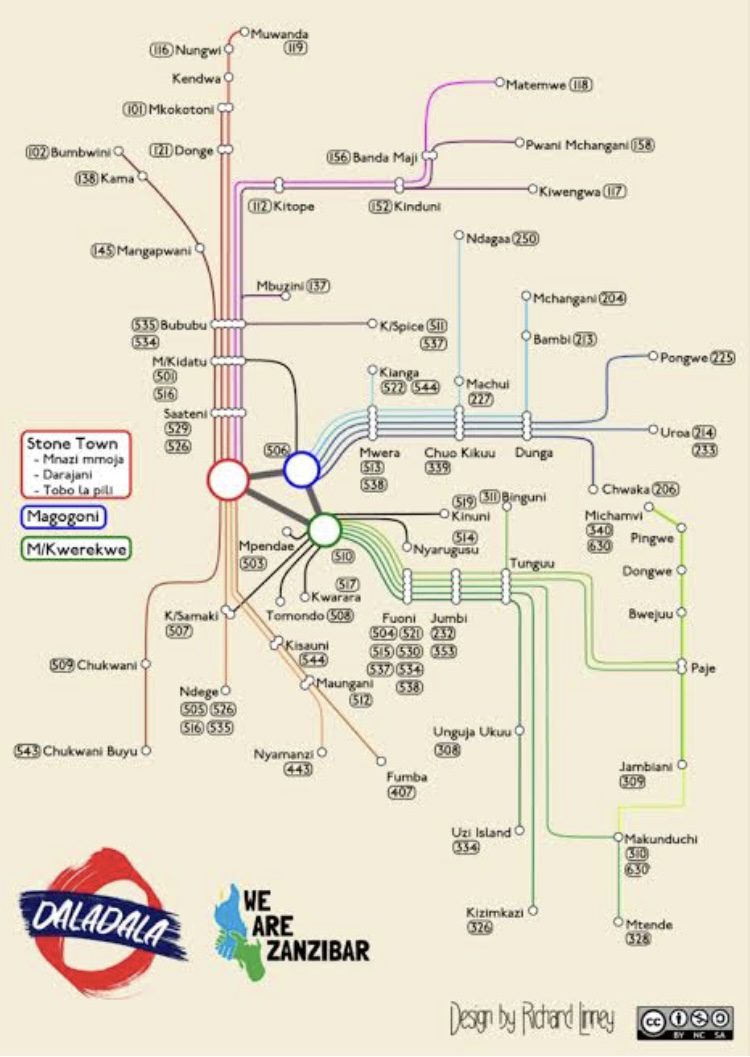Getting into Tanzania from Zambia
I took the Tazara train from Kapiri Mposhi in Zambia to Dar es Salaam. The border crossing was very smooth and I found the train ride to be very enjoyable. You can read more about it here.
Getting around Dar es Salaam
Dar es Salaam is a very congested city, so your best option in the city centre is taking a ride in a bajaj (a tuk tuk) or on a boda boda (a motorcycle). These are slim enough to make their way through congested traffic the way a dala dala (public minibus) could not. You should always try to haggle, they usually quote a price that is much too high for the distance you want to cover. In some parts like Kariakoo you can also just walk around. Be prepared for a sensual overload though. There are many people roaming around, shopping and selling everything from Baobab seeds to fake Gucci handbags. In the outskirts of the city, a dala dala will get you where you want to go better than in the city.
Getting to Zanzibar from Dar es Salaam
There used to be a slower ferry that was less expensive connecting Dar es Salaam and Zanzibar which was called Flying Horse. However, this ferry was discontinued a while ago, so now there are plenty of options of the same fast ferry service. It takes about 1,5 hours and costs 35 USD. I haggled a little – if you know your return date that will be easier – to get the ticket for the Azam ferry for 30 USD. I had the option to either pay in USD, Shilling or by credit card in USD. They charged 2 USD for the card payment. The ferry terminal is very busy with touts trying to direct you towards their ferry stall, just keep calm and check out your options before buying any ticket. There is also one other option to go to Zanzibar: a very slow boat leaving at 22.00 at night and arriving at 6.00 in the morning. Apparently it is very overcrowded, so I refrained form taking it, but if you do, let me know how it went.
Public transport on Zanzibar
There is a comprehensive public transport network on Zanzibar. The minibuses and converted trucks with benches at the back and very low roofs that are connecting all the towns on the island are called dala dalas. Most, however, run to and from Stone Town. In Stone Town there are three main dala dala stations and depending on your destination, you’ll have to find the right one. Below is a slightly outdated map of all the dala dala lines. (There is a direct connection between Paje and Nungwi that is not on the map for example.) It is still good enough to give you an idea of the network. Any local will also be happy to point you towards the right spot, mostly in exchange for a little money. The converted trucks have a very low ceiling and are really not very comfortable when overcrowded, but you’ll get a much better glimpse into the life of a local, spend less money and emit way less emissions than when getting a private taxi, which seems to be the main practice by tourists on Zanzibar.

Here is how to take a dala dala:
1, Go to a dala dala station or flag the one with the right number down from the side of the road. They all have numbers and the destination written at the front.
2, Get in and take a seat.
3, When the conductor makes a gesture towards you to pay (usually they jingle the coins they already have in their hand), ask them how much to your destination and hand them the money. Be aware that they have a practice of overcharging tourists, so try to find out how much the ride should be beforehand and insist on getting your change back at the latest when getting off. Also, speaking a little Swahili helps heaps – especially learning the numbers. As a reference, going from Stone Town to Pwani Mchangani should cost around 1700 Tanzanian Shilling (~0,7€) per person and going from Stone Town to Paje should be 2000 Tanzanian Shilling (~0,8€) per person. A short trip like Paje to Bwejuu shouldn’t be more than 500 Tanzanian Shilling (~0,2€).
4, When you want to get off a dala dala, you can call ‘conductor, shusha!’, which means that you want to get off, and the conductor will tell the driver to stop at the side of the road for you to get out. In some cases, there is no conductor, then you yell towards the driver or tap on the metal bar of the truck with a coin.
In Stone Town, there are also bajajs (tuk tuks) and boda bodas (motorcycles) that you can take for shorter inner-city trips. You can just flag them down from beside the road. Most will offer their services to you unasked if you are a white tourist in any case. Always haggle, the initial price they state will most likely be double or triple the right one.
Trains in Tanzania
Besides the Tazara train (see my experience with that one here), there are also other rather slow and run-down trains in the country. You can check most of them out on Seat 61. I took a train from Dar es Salaam to Moshi. It was a night train, departing on Friday at 14.30 going to Arusha. We arrived in Moshi at around 9.00 in the morning the next day. I had bought a seat in second class for about 10 euros, paid in Tanzanian Shilling in cash at the train station. You can also buy a ticket for a compartment where you can lie down. Sexes are not mixed in these compartments, it’s either all female or all male. The seat in second class was nothing fancy of course, but it would have been completely okay had it not been for the extremely loud music that went on for 10 hours straight until 1.30 in the morning. At the beginning of the journey, a train attendant told me where I could find the board restaurant and the ‘train DJ’s box’. I thought he simply did not have a better word in English for the guy who made the announcements. Boy was I wrong. The music started quite loud, but still alright, but then it somehow got turned louder and louder as the journey went on. Just as a side note: we’re talking about Tanzanian pop music, so nothing calm. The speakers’ sound was more than saturated, so the quality was also extremely bad. My fellow Tanzanian travellers didn’t seem to mind the music at all, they even seemed to enjoy it and could just sleep through it. I asked the train attendant if they could just turn it down a little to which I got confusing replies, but he assured me that it would be switched off around midnight. Fortunately I had ear plugs with me, so I did eventually fall asleep. Around 1.00 in the morning, music still blasting, a fellow traveller went to see the DJ box and discovered that the music was actually at an OK level in all the other carriages and they seemed not to switch it off because people were actually partying in the board restaurant wagon. He also discovered that there were switches for all the wagons and simply switched the music off for our carriage. We arrived in Moshi with a bit of a headache. The train was definitely an experience, with loads of dust coming in from the open windows and the blasting music. Next time I would rather join the party in the board restaurant wagon or take a bus.
Dala dalas in Tanzania (mainland)
The dala dalas (vans converted into minibuses) on the mainland worked pretty much the same way as on Zanzibar. In towns there are minibus stations where people will probably instantly approach you if you look like a foreigner to ask where you are going. There is a lot less overcharging for tourists involved in the more touristy place on the mainland. The drivers will play loud music – I for some reason encountered several ones who really seemed to like American country music, but it’s mostly African pop – and pick up as many people as possible. As a reference, between Moshi and Arusha I paid 3000 Shilling, which is about 1,2 euros.
Getting from Tanzania to Kenya by bus
Contrary to what I had thought, there are not many buses making the journey between Arusha and Nairobi. You can ask around at the main bus/minibus station in Arusha and people will point you towards the right ‘booth’ rather quickly. The best and actually only deal I found was a minibus for 50.000 Shillling, which in 2023 was about 20 euros, leaving in the morning and going to the Nairobi city centre. There is also a big bus, but Arusha is only a stop on its way and it stops there quite late in the afternoon. Not wanting to arrive in a new country and big city like Nairobi after nightfall, I opted for the minibus. They wanted a pre-payment, which I found suspicious, so I gave them only 5.000 Shilling, but everything turned out okay. They picked me up from the main bus station, but then transferred me into another minibus that actually left from another station as soon as the other passengers had arrived, but it was rather well organised. The land crossing between Tanzania and Kenya was straightforward. They asked us to line up our bags for a dog to sniff them, wanted me to show my yellow fever vaccination card, and then stamped me out and into Kenya in the same building. Be aware that you will have to get an e-visa for Kenya. They do not issue visas on arrival anymore.

